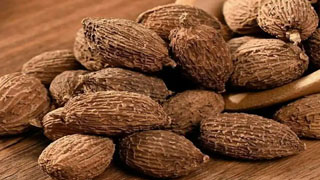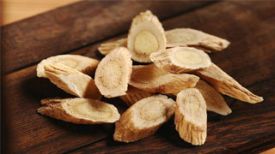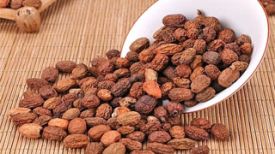
1. Alias
Shrink sand kernels, shrink sand density, shrink sand paste.
2. Plant morphology
Perennial herb. The rhizomes are cylindrical in shape, creeping on the ground, standing upright at a height of 80-200 centimeters, with a diameter of 1-1.5 centimeters, and the base is swollen and spherical. Leaves lanceolate or linear, with wavy edges and oblique parallel veins; Leaf sheaths open, embracing stems; Tongue membrane texture. Loose spike like inflorescence, with 7-13 flowers per spike; Calyx white, with 3 shallow lobes at the top; Corolla white, spoon shaped; There are yellow, red, purple, and green spots in the center of the lips; 1 stamen and 2 anthers; The ovary is located in the lower part, with 3 chambers and 10-20 ovules per chamber. The top of the style is funnel-shaped and slightly higher than the anthers. The upper part of the style and the stigma are embedded in the stamen sulcus. The fruit is initially green, then gradually turns red to purple red, and when fully ripe, it is dark purple, nearly spherical or oval in shape, with a diameter of 1.5-2 centimeters and soft thorns on the outside. 15-56 seeds, irregularly oval, rectangular or polygonal in shape. The flowering period is from March to June, and the fruiting period is from July to September.
3. Origin distribution
Wild or cultivated valley forests in shady and humid areas, distributed in Guangdong, Guangxi, Yunnan and other places.
4. Harvesting and processing
The fruit changes from bright red to purple red from August to September, and the seeds change from white to brown or black and are hard. They can be harvested when they have a strong spicy taste when chewed. Generally, the "baking method" is used, which involves spreading fresh fruits on a bamboo sieve and placing them on a stove to dry over low heat. The processing is divided into three steps: "withering", "compaction", and "reheating". When baked until the skin becomes soft (about 50-60% dry), take advantage of the opportunity to spray water once to make the skin suddenly shrink. After drying, the skin inside should be tight and without gaps. In addition, the sun drying method can also be used.
5. Characteristics of medicinal herbs
Yangchun sand and green shell sand are elliptical or oval in shape, with indistinct triangular edges, measuring 1.5-2 centimeters in length and 1-1.5 centimeters in diameter. The surface is brown in color, densely covered with thorny protrusions, with floral residues at the top and often fruit stalks at the base. The skin is thin and soft. The seeds gather into a cluster with three blunt edges and a white septum in the center. The seed cluster is divided into three petals, each containing 5-26 seeds. The seed is an irregular polyhedron with a diameter of 2-3 millimeters; The surface is brownish red or dark brown, with fine wrinkles, and is covered by a light brown membranous false seed coat; Hard in texture, with gray white endosperm. The aroma is fragrant and strong, with a spicy, cool, and slightly bitter taste. Hainan sand is elongated or oval in shape, with distinct triangular edges, measuring 1.5-2 centimeters in length and 0.8-1.2 centimeters in diameter. The surface is covered with patchy and branched soft spines, and the base has fruit stem scars. The skin is thick and hard. The seed clusters are small, with 3-24 seeds per petal; The seed diameter is 1.5-2 millimeters. The smell is slightly light.
6. Sexual Taste Returning to the Classics
Warm in nature, pungent in taste. Return to the Stomach Meridian, Spleen Meridian, and Kidney Meridian.
7. Effect and Function
Moisturize and stimulate appetite, warm the spleen to stop diarrhea, regulate qi and stabilize the fetus. It belongs to the category of dampness dispelling medicine.
8. Clinical application
Take 3-6 grams and decoct. Used to treat diseases such as water swelling, obstruction of bowel movements, accumulation of phlegm, shortness of breath, wheezing and coughing, insect accumulation, abdominal pain, roundworms, tapeworms, etc. Stir fry and grind sand kernels, soak them in bags with wine, and boil and drink.
9. Pharmacological research
Antiplatelet aggregation; Expand blood vessels; Inhibition of gastric protease activity; Inhibit gastric acid secretion; Promote intestinal motility; Pain relief, etc. Water decoction can enhance intestinal motility and significantly inhibit platelet aggregation. Clinical application has shown ideal therapeutic effects on gastric and duodenal ulcers, and it has been found that chewing sand kernels carefully and swallowing them has a good effect on treating hiccups.
10. Chemical composition
Mainly containing volatile oil, the main components are camptothecin, dextro camptothecin, acetic acid camptothecin, linalool, orange blossom tertiary alcohol, etc. Among them, acetic acid camptothecin can measure the quality of sand kernels. It also contains ingredients such as camphor, 3-triglyceride, bornyl acetate, gemeine, and alpha farnesene.
11. Usage taboos
Those with yin deficiency and heat should avoid taking it.
12. Compatibility prescription
① Digestive and moderate, lower qi to relieve heart and abdominal pain: stir fry and grind sand kernels, soak them in wine in bags, and boil and drink. (Gangmu Suosha Wine)
② Treatment of bone marrow: 4.5 grams each of sand kernel and Chinese wolfberry. Use water for two hours, add half a bowl of sugar, and fry for one hour. Take a slow sip in your mouth and take it out four or five times. (Three Immortal Soup from Selected Selections of Yangke)
③ Treating frequent tooth pain: Chewing sand kernels regularly. (Straight Point Square)
④ Treatment of oral ulcers: Sand kernel fire is used as the last ingredient, mixed with other ingredients. (A Comprehensive Guide to Traditional Chinese Medicine)
⊙ The content of the article is for clinical reference only. Non TCM professionals are not allowed to test drugs.


